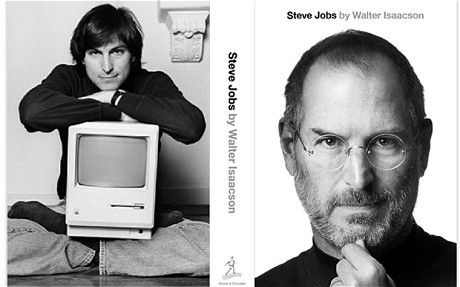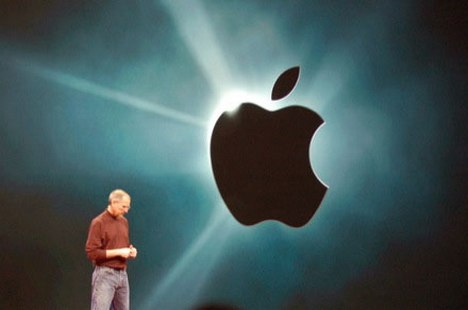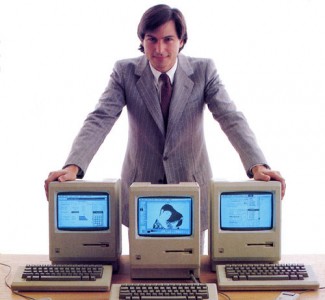Steve Jobs’ mystique was elevated even further after the authorized biography by Walter Isaacson hit the shelves a mere several days after his death–and even more after that by the release of the iPhone 4S (for Steve).
Apple devices have become ubiquitous. When In Manila, the sight of white laptops in cafes, white cords dangling from the ears of grade school students, or grandmothers swiping their fingers across an iPad, barely raises an eyebrow anymore. That is how deeply Apple has become a part of our collective consciousness.
The man who helped give the world the Mac, iTunes, the iPod, the iPhone, the iPad, Pixar and its award-winning animated films, has changed the way we live, and his impact resonates across several industries: music, publication, retail, computing, animation, design, and telecommunications.
Steve Jobs by Walter Isaacson reveals the story behind all these groundbreaking products we’ve come to know so well. More importantly, it is the story of of a remarkable individual told from a variety of perspectives, and the most resounding voice, of course, is Steve’s. Steve’s talks openly about life, death, and everything in between. And the author’s voice as heard as well; Isaacson , who interviewed Steve on numerous occasions, up to the point where Steve was undergoing chemotherapy, manages to stay objective, doesn’t pander to the recently departed, and this non-fiction account is suspenseful, emotional, incredulous, and even hilarious.
Having topped the bestseller lists and given 5 star ratings on Amazon.com, it is difficult to say who is more fortunate: Isaacson for having Steve Jobs, one of the most reclusive pubic figures, as a subject for a biography, or Jobs, for picking Isaacson to write it. Isaacson turned Steve down when he initially approached him. Isaacson surmised to himself that Steve approached him because he had previously written biographies of two of the greatest minds of all time: of Benjamin Franklin and Albert Einstein, and that Steve was already counting himself among their distinguished company.
If that was the case, it looks like they were both right.
Because we often look to the past to search for clues, several chapters are devoted to his formative years. We see how his adopted parents gave in to him because they realized that this was no ordinary child. His college years were spent on the floors of dorms, because he had decided to drop out of his course, and drop in on classes that interested him. He spent several months traveling around India, living in ashrams. When he returned, he hadn’t seemed to have reached nirvana, but he had started to abstain from meat, shaving, and taking showers.
His birthplace of Palo Alto was also very significant. There was a technological renaissance going on at the time. In Palo Alto, being an engineer was the pinnacle of achievement. And the neighborhood Steve grew up in was full of them. There were garage computer clubs, and it was here that the 16-year-old Steve and would meet another Steve (Wozniak) and together they founded Apple. With the help of an Intel engineer, they made and sold their first Apple computer. Its casing was made of wood and it didn’t have a screen.
His personal life as an adult was tumultuous as well. He had a daughter whom he refused to acknowledge, despite naming a computer (The Lisa) in her namesake. 14 years after he and Wozniak produced the Apple I, he would be fired from the very company he founded. He started NeXT computers and bought Pixar. In moves that still leave MBA’s breathless, Steve would sell Pixar to Disney and NeXT to Apple, and later on, deftly regain control of Apple.
A man already worshipped by multitudes of devotees, his marketing genius, seen through his 1984, “Think Different,” and “Here’s to the crazy ones,” advertising campaigns, his theatrical product launches at Mac World, and his ruthless pursuit of perfection at any cost have become the stuff of legend. And he walked his talk. His return to Apple saw a Jobs who was still thinking differently, and who envisioned the computer as the centerpiece of human activity, a digital hub. Then came the iPod, iTunes, and the rest is as they say, history.
The book takes the enigma, and shows us the real Steve, warts and all, as they say. For a man who was taken too early, the book is 656 pages short, and it makes one wonder, What if? What else would he have accomplished if he had been given more time? But like he said in his Stanford commencement address, “Remembering that you are going to die is the best way I know of avoiding the trap of thinking you have something to lose. You are already naked. There is no reason not follow your heart.” Regardless of when it ended, Steve lived his life to the full. And that, more than sleek designs and amazing technology, is his legacy.
Manila Must Read: Steve Jobs by Walter Isaacson book review







